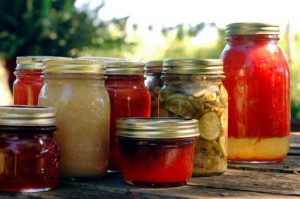By Gaye Levy
Guest writer for Wake Up World
I recently decided that I should up the ante when it comes to the items in my food storage, and holy moly have you seen the price of beans lately? Last summer I purchased a goodly quantity of beans and paid $14.95 for each 25-pound sack. And now, $19.95 for the very same quantity. That is an increase of 33%! With those kinds of prices, you can bet that I am paying close attention to my food storage habits.
For the past year, I have explored many areas of preparedness, but now with the escalation in food prices, I have taken a keen interest in food and food storage. And whereas I know a little about a lot of things, food and food storage are two areas in which I have learned the most and am able to share the most.
So, with so many new readers here at Backdoor Survival, I am posting some information on the six enemies of food storage. And for those of you that are experienced preppers? Well if you are like me, every time you read the same old stuff, more sinks in so it does not hurt to read up. Consider this a refresher course.
What are the six enemies of food storage?
- Temperature
- Moisture
- Oxygen
- Light
- Pests
- Time
As you will see, each of these factors is interrelated in such a way that there is a domino effect with all of the tiles falling upon each other and ultimately affecting your stored items in a cumulative fashion. Let’s briefly address each one so that this becomes clear.
Temperature: The optimal temperature for food storage is between 40 and 70 degrees Fahrenheit (4 °C to 21 °C). And within that range, the lower the better. To give you an idea of why a cooler temperature is best, think about this: the storage life of most food products is cut in half for every increase of 10 degrees Fahrenheit.
The second factor when it comes to temperature is consistency. So if you have a location where the temperature is 40 degrees one day and 70 the next (4 °C/21 °C) , there is going to be some loss in quality and shelf life. Let me put this another way. If you have stored your food in a garage where the temperature fluctuates between summer and winter, the shelf life will be based upon the highest temperature not the lowest.
Moisture: The ideal level of humidity for your stored food is 15% or less. I live in Washington State where the humidity is typically 60% or 70% or more. The way around the humidity and moisture issue is proper packaging. And with packaging, there are lots of choices including Mylar bags, food-grade buckets with or without gamma seals, vacuum seal bags (such as the FoodSaver), Mason or canning jars and more. What you decide to use will dictate how much light your food is exposed to (remember those dominoes?)
Oxygen: The presence of oxygen allows bacteria, microorganisms and pests to thrive and survive in your food. In addition, many nutrients oxidize in an oxygen-rich environment. Fortunately, the use of oxygen absorbers can suck out the oxygen in your food containers, leaving only product and nitrogen (which is not harmful).
Light: The easiest way to explain how light affects your stored food is to equate light to energy. When the energy of light zaps your food, it transfers some of that energy to the food itself, degrading its nutritional value, taste and appearance, This is especially true when it comes to the fat soluble vitamins such as Vitamins A, D and E.
Pests: Pests are another problem. Moisture and humidity provide a breeding ground for bugs and larvae of all types. In some climates (mine) mice are a problem. It is important to be aware of the pests that are particular to your geographical climate, and, further, that you set a barrier between your food and the critters. In addition to a physical barrier, the use of oxygen absorbers or diatomaceous earth will eliminate the oxygen (air) that most pests need to survive.
Time: The final enemy is time. And while there are many items that have an extended shelf life of 20 or 30 years, unless they are properly packaged and stored, the optimal shelf life will be considerably less. If you really do desire products with a 30-year shelf life, I suggest you look at some of the commercially packaged alternatives at Emergency Essentials, ReadyMade Resources, The Ready Store and others.
That said, once you get the hang of things, it is pretty easy to package up the bulk items yourself, and there are plenty of tools and tips for doing so all over the Internet and YouTube, plus of course, at Backdoor Survival.
The Final Word
The intent of this article is to give you a top level overview of the considerations you need to keep in mind as you begin to acquire food products for long-term storage. There is so much more of the story to tell; over time, you can expect me to go into far more detail on each of these storage considerations. In the meantime, I have already written quite a few articles providing how-to’s and other information that will assist you in combating these food storage enemies.
Depending on your interest and needs, you might want to check out the following articles posted within the last year here on Backdoor Survival:
Food storage and Beans: Using Mylar bags and a Food Saver
Food Storage Part I – A Primer on Oxygen Absorbers
Food Storage Part II: Unraveling the Mystique of Mylar Bags
Food Storage Part III: Food Grade Buckets, Lids and Gamma Seals
Food Storage Mistakes and Goofs
Enjoy your next adventure through common sense and thoughtful preparation!
About the Author
Gaye Levy lives and teaches the principles of a sustainable, self-reliant and stylish lifestyle through emergency preparation and disaster planning. She does this through her website at BackdoorSurvival.com, an online preparedness blog that provides lifestyle tools, tips, and thoughts to guide you through the back door of life in the 21st century. With an emphasis on prepping and survival, she writes about and shares practical, thoughtful, and inspirational tools for survival in uncertain times.
Backdoor Survival is currently listed on the Survival Top 50. In addition, Gaye is a frequent guest on the Preparedness Radio Network and the soon to be author of a book on 21st century preparedness. Also known as SuvivalWoman, Gaye speaks her mind and delivers her message with optimism and grace, regardless of mayhem swirling around us.
You can find Gaye through her website at Backdoor Survival, on the Backdoor Survival Page on Facebook, and as Survival_Woman on Twitter.

If you've ever found value in our articles, we'd greatly appreciate your support by purchasing Mindful Meditation Techniques for Kids - A Practical Guide for Adults to Empower Kids with the Gift of Inner Peace and Resilience for Life.
In the spirit of mindfulness, we encourage you to choose the paperback version. Delve into its pages away from screen glare and notifications, allowing yourself to fully immerse in the transformative practices within. The physical book enriches the learning process and serves as a tangible commitment to mindfulness, easily shared among family and friends.
Over the past few years, Wake Up World has faced significant online censorship, impacting our financial ability to stay online. Instead of soliciting donations, we're exploring win-win solutions with our readers to remain financially viable. Moving into book publishing, we hope to secure ongoing funds to continue our mission. With over 8,500 articles published in the past 13 years, we are committed to keeping our content free and accessible to everyone, without resorting to a paywall.







